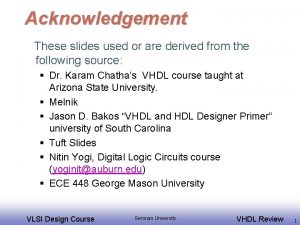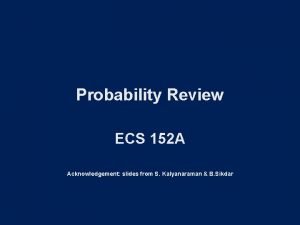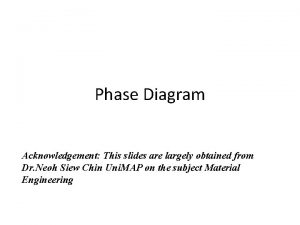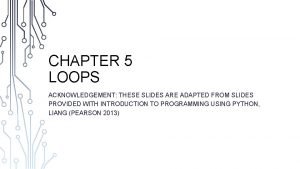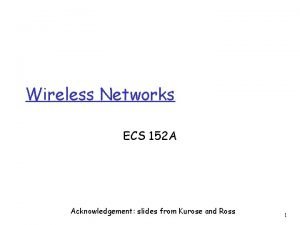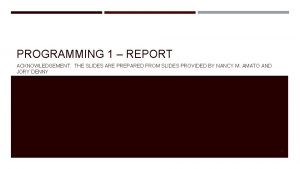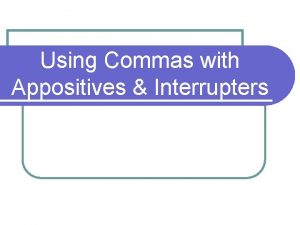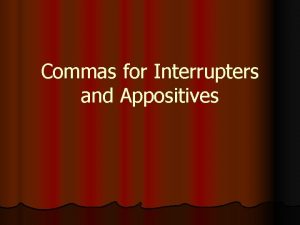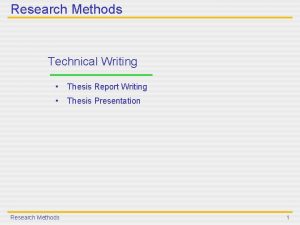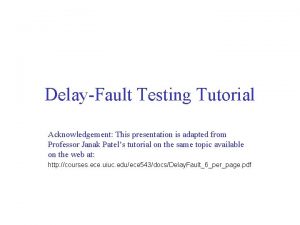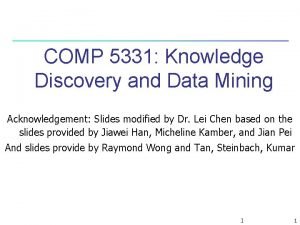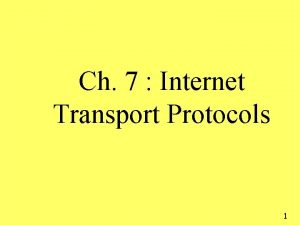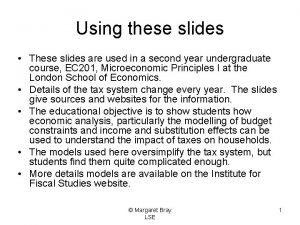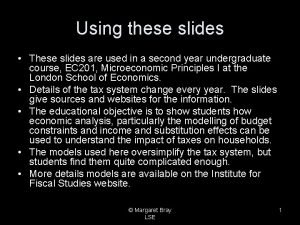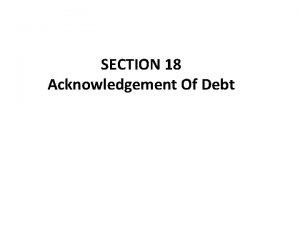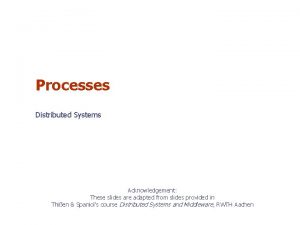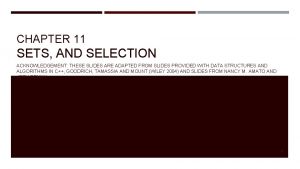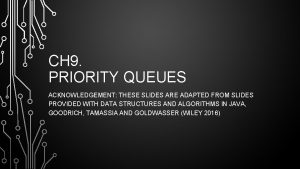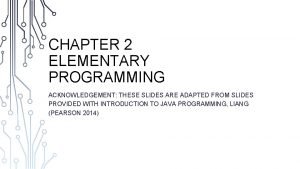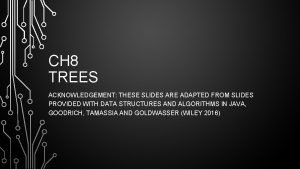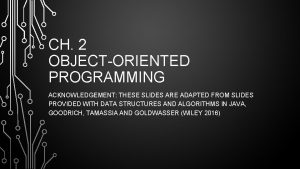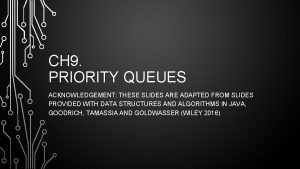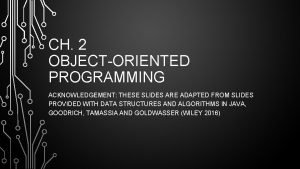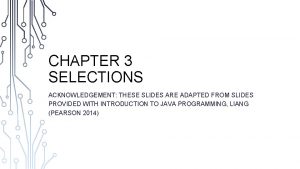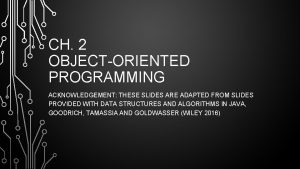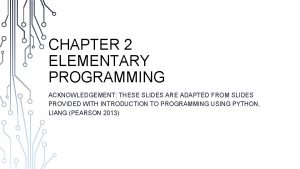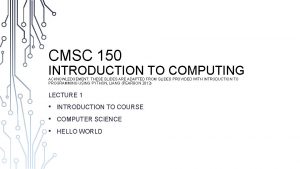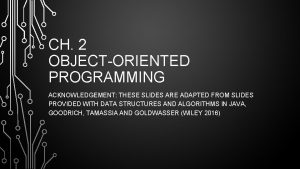Acknowledgement These slides used or are derived from































- Slides: 31

Acknowledgement These slides used or are derived from the following source: § Dr. Karam Chatha’s VHDL course taught at Arizona State University. § Melnik § Jason D. Bakos “VHDL and HDL Designer Primer” university of South Carolina § Tuft Slides § Nitin Yogi, Digital Logic Circuits course (yoginit@auburn. edu) § ECE 448 George Mason University VLSI Design Course Semnan University VHDL Review 1

Part 2: A Quick VHDL Review

Intro to VHDL q Need for Hardware Description Languages § Systems become more complex § Design at the gate and flip-flop level becomes very tedious and time consuming q HDLs allow § Design and debugging at a higher level before conversion to the gate and flip-flop level § Tools for synthesis do the conversion q q VHDL, Verilog VHDL – VHSIC Hardware Description Language VLSI Design Course Semnan University VHDL Review 3

Intro to VHDL q Developed originally by DARPA § for specifying digital systems q q International IEEE standard (IEEE 1076 -1993) Hardware Description, Simulation, Synthesis Provides a mechanism for digital design and reusable design documentation Support different description levels § Structural (specifying interconnections of the gates), § Dataflow (specifying logic equations), and § Behavioral (specifying behavior) q Top-down, Technology Dependent VLSI Design Course Semnan University VHDL Review 4

VHDL (Appendix B in Textbook) q q q HDL => VHDL / Verilog VHDL more verbose, better for team projects Not case-sensitive VHDL => “VHSIC Hardware Description Language” VHSIC => “Very-High-Speed Integrated Circuit” Do. D project § § q Used to describe behavior of digital logic § q Document behavior of ASICs from suppliers Alternative to manuals Extensions for analog High-level programming language, subset of Ada § Also looks like Pascal q IEEE standards: 1987, 1993, 2000, 2002, 2008 q First came the language… …next came simulators… …then came synthesizers (FPGA and ASIC) q q VLSI Design Course Semnan University VHDL Review Fund. of VLSI Chip

VHDL q By its nature, VHDL is § Self-documenting § Allows for easy testbench design (simulators, instruments) q q Any VHDL code may be simulated Only some VHDL codes may be synthesized § Depends on packages, data types, and constructs q q VHDL descriptions (programs) have structure similar to C++ Each design (component) is made up of § Entity section – Component interface (I/O) – Analogous to C++ header (public methods only) § Architecture section – Contains behavior (implementation) – Can have multiple architectures for any entity – Example: different types of adders with consistent interfaces VLSI Design Course Semnan University VHDL Review Fund. of VLSI Chip

Subsequent versions of VHDL § IEEE-1076 1987 § IEEE-1076 1993 ← most commonly supported by CAD tools § IEEE-1076 2000 (minor changes) § IEEE-1076 2002 (minor changes) § IEEE-1076 2008 VLSI Design Course Semnan University VHDL Review

Basic Form of VHDL Code • Every VHDL design description consists of two parts: • entity • architecture • The entity section is used to declare I/O ports of the circuit. • The architecture portion describes the circuit’s behavior. VLSI Design Course Semnan University VHDL Review

Basic Form of VHDL Code (cont. ) • Every VHDL design description consists of at least: • one entity / architecture pair, • or one entity with multiple architectures. • A behavioral model is similar to a “black box”. • Standardized design libraries are included before entity declaration. VLSI Design Course Semnan University VHDL Review

Entity Declaration • • • An entity declaration describes the interface of the component. PORT clause indicates input and output ports. An entity can be thought of as a symbol for a component. VLSI Design Course Semnan University VHDL Review

Port Declaration • • PORT declaration establishes the interface of the object to the outside world. Three parts of the PORT declaration • Name • Any identifier that is not a reserved word. • Mode • In, Out, Inout, Buffer • Data type • Any declared or predefined datatype. • Sample PORT declaration syntax: VLSI Design Course Semnan University VHDL Review

Entity Declaration q Entity Declaration describes an interface of the component, i. e. input and output ports. Entity name Port names Port type ENTITY nand_gate IS PORT( a : IN STD_LOGIC; b : IN STD_LOGIC; z : OUT STD_LOGIC ); END nand_gate; Semicolon No Semicolon after last port Reserved words Port modes (data flow directions) VLSI Design Course Semnan University VHDL Review ECE 448 – FPGA

VHDL entity q entity my_ckt is port ( A: in bit; B: in bit; S: in bit; X: out bit; Y: out bit ); end my_ckt; Port names or Signal names § § § A B § Datatypes: Name of the circuit § In-built User-defined § User-defined Filename same as circuit name recommended Example: X § Circuit name: my_ckt § Filename: my_ckt. vhd Y S Direction of port 3 main types: § in: Input out: Output Note the§ absence of semicolon § inout: Bidirectional “; ” at the end of the last signal and the presence at the end of the closing bracket 13 VLSI Design Course ELEC 2200 -002 Lecture 7 (updated) Semnan University VHDL Review Fall 08, Oct 29

Architecture Declaration • • • Architecture declarations describe the operation of the component. Many architectures may exist for one entity, but only one may be active at a time. An architecture is similar to a schematic of the component. VLSI Design Course Semnan University VHDL Review

Example VHDL Code q q q 3 sections to a piece of VHDL code File extension for a VHDL file is. vhd Name of the file should be the same as the entity name (nand_gate. vhd) [Open. Cores Coding Guidelines] LIBRARY ieee; USE ieee. std_logic_1164. all; LIBRARY DECLARATION ENTITY nand_gate IS PORT( a : IN STD_LOGIC; b : IN STD_LOGIC; z : OUT STD_LOGIC); END nand_gate; ENTITY DECLARATION ARCHITECTURE model OF nand_gate IS BEGIN z <= a NAND b; END model; ARCHITECTURE BODY VLSI Design Course Semnan University VHDL Review ECE 448 – FPGA

Libraries VLSI Design Course Semnan University VHDL Review ECE 448 – FPGA

Library Declarations LIBRARY ieee; USE ieee. std_logic_1164. all; Library declaration ENTITY nand_gate IS PORT( a : IN STD_LOGIC; b : IN STD_LOGIC; z : OUT STD_LOGIC); END nand_gate; Use all definitions from the package std_logic_1164 ARCHITECTURE dataflow OF nand_gate IS BEGIN z <= a NAND b; END dataflow; VLSI Design Course Semnan University VHDL Review ECE 448 – FPGA

Library declarations - syntax LIBRARY library_name; USE library_name. package_parts; VLSI Design Course Semnan University ECE 448 – FPGA and ASIC Design with VHDL Review. VHDL

Fundamental parts of a library LIBRARY PACKAGE 1 PACKAGE 2 TYPES CONSTANTS FUNCTIONS PROCEDURES COMPONENTS VLSI Design Course Semnan University TYPES CONSTANTS FUNCTIONS PROCEDURES COMPONENTS ECE 448 – FPGA and ASIC Design with VHDL Review. VHDL

Libraries q ieee Specifies multi-level logic system, including STD_LOGIC, and STD_LOGIC_VECTOR data types q std Specifies pre-defined data types (BIT, BOOLEAN, INTEGER, REAL, SIGNED, UNSIGNED, etc. ), arithmetic operations, basic type conversion functions, basic text i/o functions, etc. q Need to be explicitly declared work Holds current designs after compilation VLSI Design Course Semnan University Visible by default ECE 448 – FPGA and ASIC Design with VHDL Review. VHDL

BIT versus STD_LOGIC BIT type can only have a value of '0' or '1' q STD_LOGIC can have nine values q § '0', '1', 'Z', 'U', 'X', 'L', 'H', 'W', '-' Useful mainly for simulation § '0', '1', and 'Z' are synthesizable (your codes should contain only these three values) VLSI Design Course Semnan University VHDL Review

Built-in Datatypes q Scalar (single valued) signal types: § bit § boolean § integer § Examples: – A: in bit; – G: out boolean; – K: out integer; q Aggregate (collection or array) signal types: § bit_vector: array of bits representing binary numbers § signed: array of bits representing signed binary numbers § Examples: – D: in bit_vector(0 to 7); – E: in bit_vector(7 downto 0); – M: in signed (4 downto 0); --signed 5 bit_vector binary number 22 VLSI Design Course ELEC 2200 -002 Lecture 7 (updated) Semnan University VHDL Review Fall 08, Oct 29

User-defined datatype Construct datatypes arbitrarily or using built-in datatypes q Examples: q § type temperature is (high, medium, low); § type byte is array(0 to 7) of bit; 23 VLSI Design Course ELEC 2200 -002 Lecture 7 (updated) Semnan University VHDL Review Fall 08, Oct 29

VLSI Design Course Semnan University VHDL Review 24

Process • • • Contains sequentially executed statements Execution is controlled either via – sensitivity list (contains trigger signals), or – wait-statements (Executed when one of the signals in the sensitivity list has an event) Be careful about incomplete sensitivity list. Exists within an architecture only Several processes run concurrently The process label is optional architecture RTL of AND_OR_XOR is begin A_O_X: process (A, B) begin Z_OR <= A or B; Z_AND <= A and B; Z_XOR <= A xor B; end process A_O_X ; end RTL; VLSI Design Course Sensitivity list architecture RTL of AND_OR_XOR is begin A_O_X: process begin Z_OR <= A or B; Z_AND <= A and B; Z_XOR <= A xor B; wait on A, B; end process A_O_X ; end RTL; Semnan University VHDL Review

Data Objects • Constants : Holds a value that cannot be changed within the design description constant width: integer: =8; • (The identifier width may be used several times in the code. ) Signals : represent wires, used to interconnect components • Variables : used in processes and subprograms • VLSI Design Course Semnan University VHDL Review

Data Objects • There are three types of data objects: • Signals • Can be considered as wires in a schematic. • Can have current value and future values. • Variables and Constants • Used to model the behavior of a circuit. • Used in processes, procedures and functions. VLSI Design Course Semnan University VHDL Review

Constant Declaration • • A constant can have a single value of a given type. A constant’s value cannot be changed during the simulation. Constants declared at the start of an architecture can be used anywhere in the architecture. Constants declared in a process can only be used inside the specific process. CONSTANT constant_name : type_name [ : = value]; CONSTANT rise_fall_time : TIME : = 2 ns; CONSTANT data_bus : INTEGER : = 16; VLSI Design Course Semnan University VHDL Review

Signal Declaration • • Signals are used for communication between components. Signals are declared outside the process. Signals can be seen as real, physical signals. Some delay must be incurred in a signal assignment. VLSI Design Course Semnan University VHDL Review

Variable Declaration • • Variables are used for local storage of data. Variables are generally not available to multiple components or processes. All variable assignments take place immediately. Variables are more convenient than signals for the storage of (temporary) data. VLSI Design Course Semnan University VHDL Review

Variable Declaration(Cont’d) architecture example of and 8 is begin Note: Variable does my_and: process (a_bus) not represent wires variable tmp: bit; like signals begin tmp: =‘ 1’; for i in 7 downto 0 loop tmp: = a_bus(i) and tmp; end loop; x<=tmp; end process my_and; end example; VLSI Design Course Semnan University VHDL Review
 Insidan region jh
Insidan region jh Acknowledgement for ppt presentation
Acknowledgement for ppt presentation Acknowledgement slides
Acknowledgement slides Acknowledgement slides
Acknowledgement slides Acknowledgement slides
Acknowledgement slides Acknowledgement slides
Acknowledgement slides Acknowledgement slides
Acknowledgement slides Templates
Templates Acknowledgement slides
Acknowledgement slides Acknowledgement slides
Acknowledgement slides A small child slides down the four frictionless slides
A small child slides down the four frictionless slides A spring loaded gun shoots a plastic ball
A spring loaded gun shoots a plastic ball These slides
These slides Teacher gists
Teacher gists Following slides
Following slides How are written codes used in each of this poster
How are written codes used in each of this poster Conventions of a film poster
Conventions of a film poster Interrupter in english
Interrupter in english Habitual past action with would
Habitual past action with would Commas for interrupters
Commas for interrupters Technical background in research example
Technical background in research example Acknowledgement in presentation
Acknowledgement in presentation Dont reply all
Dont reply all Acknowledgement in presentation
Acknowledgement in presentation Acknowledgement slide
Acknowledgement slide Tcp reno vs tahoe
Tcp reno vs tahoe Acknowledgement for english project
Acknowledgement for english project Acknowledgement for presentation
Acknowledgement for presentation Western sydney uni library
Western sydney uni library Kaurna land or kaurna country
Kaurna land or kaurna country Statisticvital certificate
Statisticvital certificate Acpa land acknowledgement
Acpa land acknowledgement


